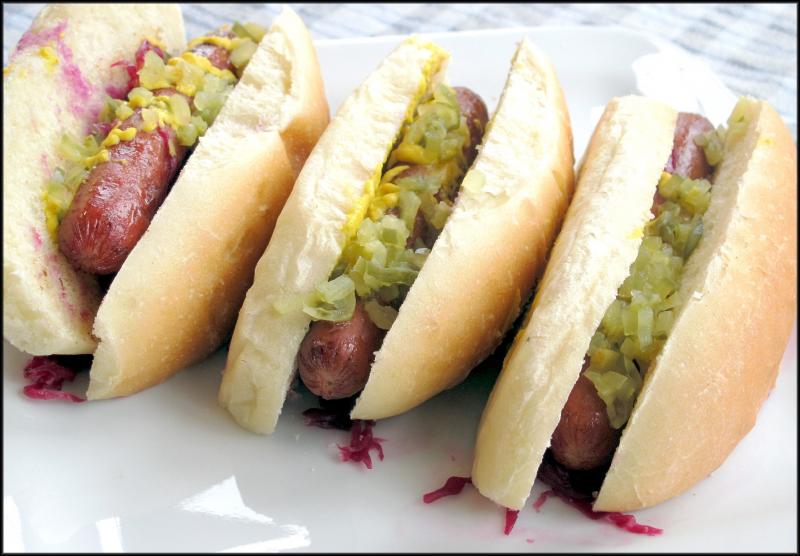Wherever they came from, hot dogs are an American cookout classic
Monday is Labor Day, when we typically celebrate the end of summer with friends and family at pool parties and backyard barbecues. In this era of COVID-19, with the ongoing need for social distancing and avoiding crowds, the parties will likely be much smaller and may only extend as far as the members of your household.
That doesn’t mean you can’t enjoy a picnic on your own porch or patio – just fire up the grill to cook the signature foods we associate with hot coals (or gas jets) on the barbecue. For this holiday, instead of the usual burgers or ribs, we’re going to treat ourselves to the salty, fatty deliciousness of hot dogs.
Technically, the food we call a “hot dog” is actually a type of sausage, one of the oldest forms of processed foods, mentioned as early as the ninth century BC, in Homer’s Odyssey. The owner of bragging rights for inventing the modern incarnation of the “dachshund” or “little-dog” sausage has long been debated by food historians.
Some point to the the town of Frankfurt as the origin, hence the name “frankfurter.” Others assert they originated in Vienna, which would explain why they’re called “weiners.” No matter who was first, the most likely explanation for their appearance in North America can be traced to the vast numbers of European immigrants, each bringing their version of a seasoned sausage.
The next debate centers around who thought of serving the sausage on a handheld roll. Whether sold from pushcarts in New York City’s Bowery or from a stand on Coney Island, the consensus is that the practice of combining a sausage with bread is a German tradition. By 1893, they were a popular treat at the Columbian Exposition in Chicago, and hot dogs had also found their way to ballparks and college dorms.
Which brand of hotdog and exactly how to serve them are topics of intense debate. We’ve all seen the displays at supermarkets with brands from Nathan’s to Sabrett (popular New York City names) to Hebrew National, Oscar Mayer and Ball Park. They can be made from all beef, or mixtures of beef and pork, or as pseudo-dogs made with turkey or plant protein (yes, there are “impossible” hot dogs, too).
I think this is a choice that is largely determined by what you were served when you were a kid. That familiar combination of seasoning, fatty juiciness and crisp snap of the casing are hard-wired from our childhood. Ours were always Hebrew National. The same is true when it comes to how you like them cooked: boiled, fried or grilled.
I am not a boiled hot dog fan, although there was a chain that boiled them in beer, which was pretty tasty. I don’t always enjoy the blackened spots from grilling, so I prefer mine browned in butter. The next decision is what type of bun: potato bun, doughy white bread or an Italian roll from Old World Breads? As for side dishes, I’ve included recipes to serve with your hot dogs.
Finally, how will you dress those dogs? For the ones in the photo, we started with a layer of red-cabbage sauerkraut from Lloyd’s Market for crunch and salt. We then topped the dogs with scoops of relish and squirts of yellow mustard. I realize these are personal choices, and there may even be a few of you who reach for the ketchup bottle. No matter how you enjoy your hot dogs, be sure to enjoy Labor Day.
Slow Cooker Baked Beans
1 lb dried navy beans
6 C water
1 C maple syrup
4 slices bacon, chopped
1 diced onion
1/2 C ketchup
1 T tomato paste
2 t Worcestershire sauce
1 t mustard powder
1 t paprika
salt, to taste
Parboil the beans by combining beans and water in a 3-quart saucepan. Bring to a boil over high heat; reduce heat to low and simmer 5 minutes. Remove from heat and allow to soak for 1 hour. Drain beans, reserving cooking liquid. Transfer beans to slow cooker and add remaining ingredients, except salt. Add 1/2 C reserved cooking liquid. Cover and cook on high for 6 to 7 hours. Check periodically to see if they are becoming too dry, adding reserved liquid if needed. Season to taste with salt. Yield: 8 to 10 servings.
Corn Salad
8 ears corn
2 large tomatoes, diced
1/2 C diced red onion
1/3 C diced red bell pepper
1/4 C minced parsley
1 T minced basil leaves
1/2 C olive oil
1/4 C apple cider vinegar
juice of 1 lemon
1/2 t lemon zest
1/4 t cayenne
salt, to taste
Husk the corn and remove silk. It is not necessary to cook the corn, but, if desired, you may boil the ears for 5 minutes. Trim the kernels from the cobs and place in a serving bowl. Add tomatoes, onions, red bell pepper, parsley and basil. In a measuring cup, whisk together oil, vinegar, lemon juice, zest and cayenne. Pour dressing over salad and toss to combine. Season to taste with salt. Yield: 8 to 10 servings.

















































